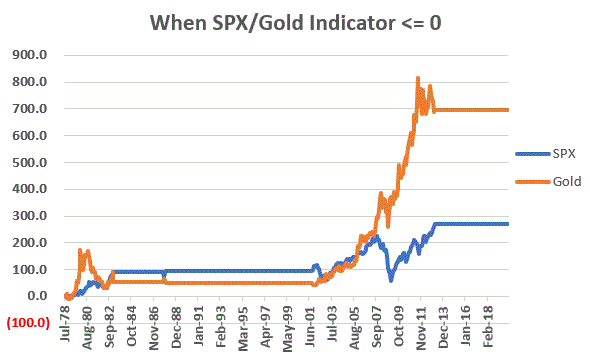In the long run the stock market goes up. Of course, there are some harrowing declines – not to mention long periods of time when no forward progress is made – along the way. At the same time gold holds a certain allure for many investors as a “store of value” during times of crisis. Nevertheless, it too can be a performance “dog” for surprisingly long period of time.
And “yes”, there is some – forgive me for using some highly complex and technical terms here – ying and yang to their relative performance. In other words, sometimes SPX significantly outperforms and other times gold outperforms. What follows is NOT intended to be a trading “system”, but rather just a simple tool that can allow the average investor to get a handle on where the ongoing SPX/Gold battle stands.
The Indicator
We are going to use a very simple tool to track the SPX/Gold trend, by applying a 60-month exponential moving average:
a) At the end of each month divide the price of the S&P 500 Index (SPX) by the price of gold bullion
b) Multiply last month’s moving average by 0.9672
c) Multiply this month’s ratio (value “a” above) by 0.0328
d) Add b and c together to get this month’s updated moving average
e) (a – d)
If “e” is positive it means stocks are outperforming and if “e” is negative it means gold is outperforming.
Again, I do not necessarily recommend using this systematically for trading purposes, however, it can be very helpful in terms of helping to filter out a lot of the “noise” that surrounds the markets. If value “e” is trending higher there is typically not much reason to pay attention to all the voices of gloom and doom shouting that you should “pile into gold” before its too late. And likewise, if value “e” goes negative it may strongly suggest that now is a good time to cut back on stock market exposure and/or to allocate to other types of assets.
The Present
As of the end of January 2020 – according to the data I use:
a) 3225.52 (SPX) / 1,573.80 (Gold) = 2.0495
b) Last month’s moving average (1.9367) x .9672 = 1.8732
c) This month’s ratio (2.0495) times 0.0328 = 0.0672
d) 1.873 + 0.0672 (b + c) = 1.9449
e) 2.0495 – 1.9449 (a – d) = 0.1046
OK, that was fun. Anyway, in a nutshell, value “e” is positive so this indicator favors stocks.
Does this matter?
The History
Figure 1 displays the SPX/Gold ratio going back to 1978 along with the 60-month exponential moving average

Figure 1 – SPX/Gold Ratio with 60-month EMA (1978-present)
Figure 2 displays the history of value “e”. As you can see while there are inevitable whipsaws, the value will tend to stay above 0 for long periods of time and then hold below 0 for a period of time.

Figure 2 – SPX/Gold Ratio minus its 60-month EMA
When the SPX/Gold Indicator > 0 versus When the SPX/Gold Indicator < 0
Figure 3 displays the total return for SPX and the total return for Gold ONLY during those months when value “e” was greater than 0 at the end of the previous months.

Figure 3 – Total Cumulative % return for SPX and Gold when Indicator > 0
Figure 4 displays the total return for SPX and the total return for Gold ONLY during those months when value “e” was less than or equal than 0 at the end of the previous months.

Figure 4 – Total Cumulative % return for SPX and Gold when Indicator <= 0
Figure 5 contains the values displayed in Figures 3 and 4.

Figure 5 – SPX and Gold performance based on whether SPX/Gold Ratio minus 60-month EMA is > 0 or <= 0 (1978-2020)
As I said, I wouldn’t shift my entire portfolio from stocks to gold automatically – and vice versa – every time this indicator flips from positive to negative and vice versa. But the historical reality is that:
Stocks have vastly outperformed gold when the SPX/Gold Ratio is above its 60-month EMA
Gold has significantly outperformed stocks when the SPX/Gold Ratio is below it’s 60-month EMA
With the indicator still firmly ensconced in positive territory, it still favors stocks over gold. But the day will come when this will change. Tracking this indicator gives investors a way to know when that day has arrived.
Jay Kaeppel
Disclaimer: The information, opinions and ideas expressed herein are for informational and educational purposes only and are based on research conducted and presented solely by the author. The information presented does not represent the views of the author only and does not constitute a complete description of any investment service. In addition, nothing presented herein should be construed as investment advice, as an advertisement or offering of investment advisory services, or as an offer to sell or a solicitation to buy any security. The data presented herein were obtained from various third-party sources. While the data is believed to be reliable, no representation is made as to, and no responsibility, warranty or liability is accepted for the accuracy or completeness of such information. International investments are subject to additional risks such as currency fluctuations, political instability and the potential for illiquid markets. Past performance is no guarantee of future results. There is risk of loss in all trading. Back tested performance does not represent actual performance and should not be interpreted as an indication of such performance. Also, back tested performance results have certain inherent limitations and differs from actual performance because it is achieved with the benefit of hindsight.

